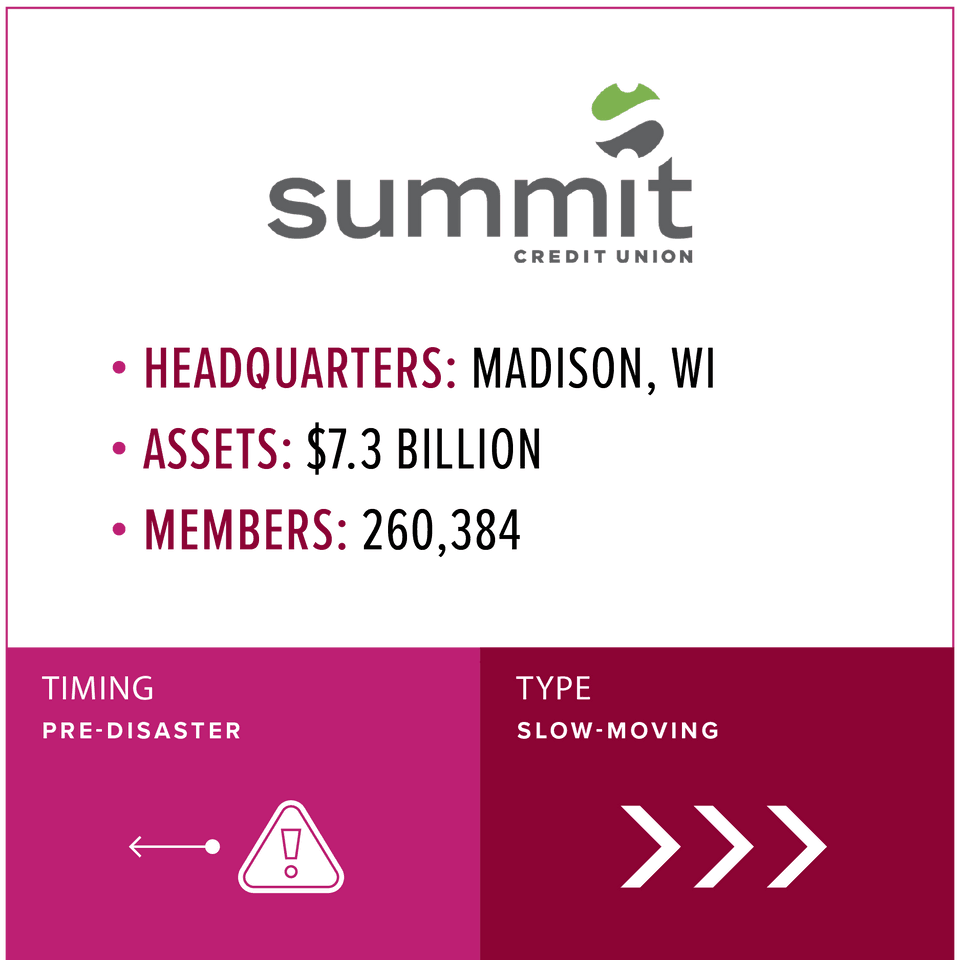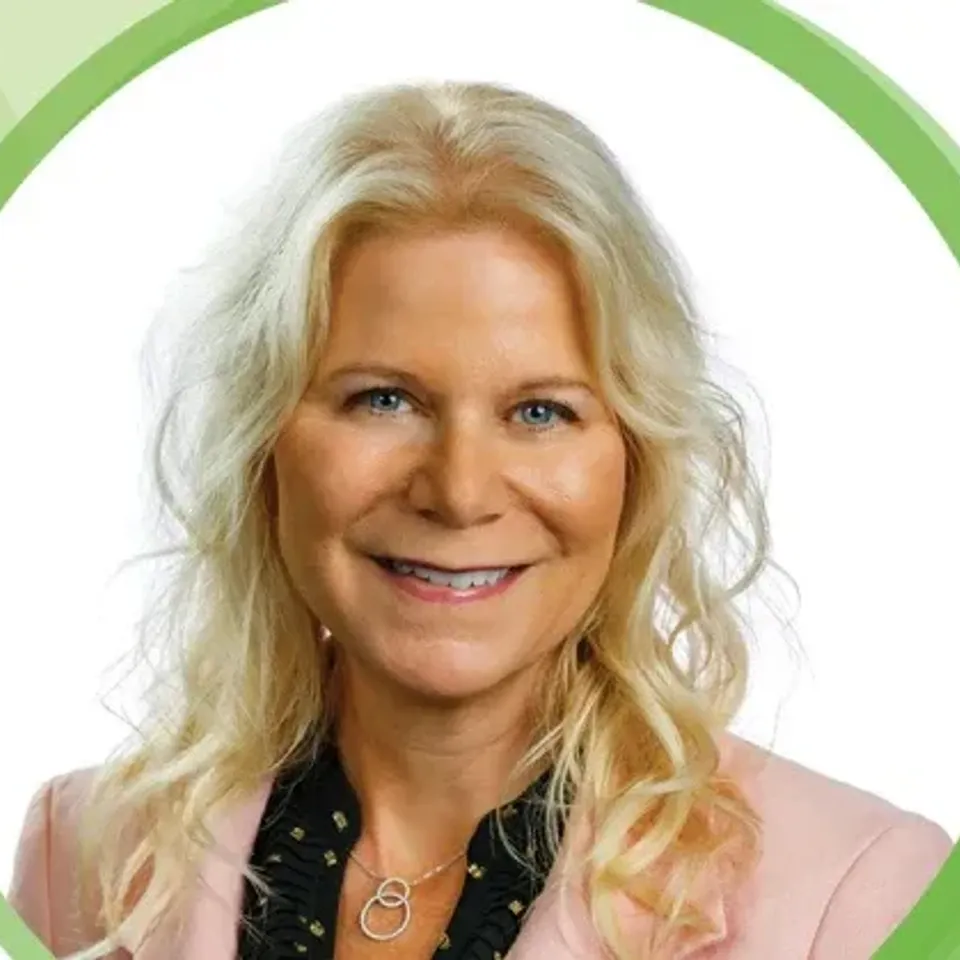Overview
What is sustainability? For some people, it means the ability to sustain organizational or financial health. For others, it is the ability for a community to protect the health of its local environment. For others still, it is reducing the human contribution to global warming. Whether your idea of sustainability is about making a local impact or a major global impact, you may feel overwhelmed by how to move your organization or community into the future with sustainable health. Below, we present how one credit union takes on sustainability with easy, manageable steps as well as ambitious, large projects.

Summit Credit Union, based in Madison, Wisconsin, has been a leader in financial and community sustainability for decades, known for its focus on supporting women and their families in avoiding poverty. Summit was established in 1935 and has grown to 61 branches across the state with 258,000 members and $7.2 billion in assets. As both a Global Alliance Banking Values (GABV) member and a strategic partner with Filene, Summit is also committed to reducing its carbon footprint, what it states is an effort to “live more lightly on the planet” and model best practices for other credit unions.
Being fully committed to long-term sustainability for our employees, members and communities includes the environment, too.
Summit Credit Union
Where does a credit union start with the nebulous term “reducing carbon footprint”? To reduce their Greenhouse Gas Emissions (GHG), Summit developed a process that has helped it make more environmentally sustainable choices. Stephen Lee, a Sustainability Facility Management Professional (SFP) who helps guide Summit on instituting sustainable programs, gives us details below.
Assess
GHG emissions are difficult to assess because your organization’s emissions include resource usage at your facilities or at events as well as emissions expended by employees and members accessing your services. But it is critical to try to estimate your existing use of energy, paper, and water to find ways to reduce, reuse, recycle, or innovate.
They work from the inside out. First, Summit looks for what can be done internally for facilities, then employees, then members to reduce consumption. They seek employee input through a “green team” and a “green page” on their intranet so information and education and connections can be shared easily. Every area of consumption is assessed from lighting to landscaping to paper use and furniture.
Living and Working Green is Our Responsibility and Privilege

Lee writes, “One way an organization can assess its environmental impact is to establish an energy and water benchmarking program. Like most other businesses on the journey, Summit started by identifying ways we could make impacts and have taken many steps in that direction and made great progress. We're researching benchmarking—which is a process which captures historical and trending data of a building’s energy and water consumption.”
With a proper assessment of the credit union’s overall consumption across its facilities, Summit uses the information to help guide decision making on which projects will be most effective in lowering greenhouse gas emissions.
Prioritize for Budget and Reality
Prioritization is important when determining what activities or environmental initiatives to enact, because in most cases—it simply is not feasible to do it all at once. They make sustainable operations part of our facilities team focus so that each building can function as efficiently as possible and so that activities that do not need to be done on-site can take place remotely, saving gas needed to travel.
Jeremy Eppler, Vice President Risk Management & Facilities, writes, “We assess the potential positive impact the activity will have on the environment, as well as the other factors needed for implementation such as time and resources. We strive to identify high impact activities while also remaining cost conscientious.”
He adds, “A recent project we are wrapping up included installing remote HVAC controls at most Summit branches. This allows us to schedule thermostats according to “occupied” and “unoccupied” times of the day, as well as manage temperature band setpoints from our headquarters. We can view both real time and historical trends of building temperatures, identify any problems, and sometimes identify the root cause of an issue before staff or a vendor arrive on site.”
Controlling temperature levels and lighting to conserve energy are easy changes that greatly organizational costs as well as GHG. Whenever facilities need roof repairs or when there is new construction, Summit applies elastomeric white membrane roofing to reflect heat loads. Further, Summit has adjusted lighting timers in parking lots to avoid unneeded runtimes and replaced interior light fixtures and exterior signage with LED fixtures in multiple locations. They also swapped employee computers for more energy-efficient versions. These changes have saved more than 50,000 kilowatt-hours annually.
Vincent Rice, Vice President Community and Business Impact, adds, “we host a ‘Shred Fest’ annually for members, we’ve switched to energy-efficient computers and reduced paper usage, and we make sustainable choices in landscaping and construction projects—and that’s only a few of the many ways we’re working to live more lightly on our planet.”
Summit prints training materials in an eco-friendly font, has added projectors to more meeting rooms to reduce paper reports, and offers e-learning to employees to reduce both fuel and paper use. In all of their branches, they provide biodegradable/compostable cups and have installed drinking fountains with a bottle refill feature. For landscaping, Summit installs low-water plantings and rock-based landscape beds that reduce the need for pesticides in weed control.
When it comes to furnishing and fixtures—which are expensive and create substantial GHG in their manufacture—Summit reuses as much as possible. They install refurbished cubicles and furniture. When items are no longer appropriate for Summit’s use, they donate furniture to local nonprofits. And they recycle lighting materials and old appliances and work with flooring contractors that recycle old carpeting instead of sending it to a landfill.
Summit has also offered a Community Supported Agriculture (CSA) program to its workforce since 2014. This program gives employees access to fresh produce and supports local farmers.
Practice What You Preach
CEO Kim Sponem has articulated that Summit’s first commitment to sustainability is within the organization, so that it can model sustainable choices for the entire community. Jeremy Eppler adds, “At Summit, running our business in a sustainable, earth-friendly way isn’t something that’s “nice” to do—it’s something that speaks to the very heart of our commitment to our members and our community.”
When Summit decided to build a new headquarters, the leadership wanted to include design and building techniques that would demonstrate sustainability to the Madison community. They sought LEED (Leadership in Energy and Environmental Design) certification by the U.S. Green Building Council, which is the world's most widely used green building rating system. LEED-certified buildings save money, improve efficiency, lower carbon emissions, and create healthier places for people. The Summit team needed to get educated first.
As Eppler writes, “Summit Credit Union met with our building architect to discuss the LEED-certification framework. Our architect facilitated an exercise to help us understand the LEED requirements and together, we discussed what targets were appropriate and achievable based on our specific situation.”
The headquarters was built in 2018 and earned a Silver LEED certification. The building includes rainwater collection, environmentally friendly landscaping, solar car chargers, white and green roofs, composting and recycling collection, and efficient heating and cooling systems.
As Vincent Rice writes, “It is difficult to quantify the comprehensive impact of the certification, but it has resulted in less water usage, less energy consumption, and reduced the environmental impact of the overall project.”
As a symbol of community leadership, watch the video below of Stacy Reese, former Sustainability Program Coordinator for the City of Madison — commenting on how Summit served as a source of inspiration.
In 2014, Summit Credit Union received the Certificate of Engagement for Outstanding Commitment to Sustainability as a MPower Business Champion. Summit was also chosen to be part of the Green Masters Program of the Wisconsin Sustainable Business Council in recognition of sustainable actions.
Advice for Other Credit Unions
Summit’s green team advises not to overlook even small changes a credit union can make or encourage that can reduce GHG within the larger community. Like many financial institutions, Summit has online and mobile banking options, which reduces the need for members to visit a branch in-person. When members do visit a branch, Summit has signage that reminds members at drive-ups to reduce engine idling and they provide free e-waste recycling.
Stephen Lee sees that “Affecting positive change in terms of environmental impact is a journey.” Whether it’s reusing office furniture, minimizing printing, improving recycling habits, implementing energy efficient lighting, or any number of other initiatives—an organization’s impact can quickly add up.
He adds, “Small credit unions may also find it beneficial to inquire with local community partners, chambers of commerce, or entities that specialize in sustainable building operations to help guide their sustainability journey.”
A Message from Summit's CEO

Credit Union Takeaways
Summit Credit Union has implemented several initiatives to reduce its carbon footprint and promote sustainability. These practices demonstrate Summit's commitment to sustainability and serve as a model for other organizations looking to reduce their environmental impact. Here are the key takeaways:
- Begin with assessment and benchmarking: Developed a process to assess Greenhouse Gas Emissions (GHG) by estimating energy, paper, and water usage. This assessment helps guide decision-making on effective projects to lower emissions.
- Work from the inside out: Start with what can be done internally for facilities and staff to reduce consumption. Once you’ve maximized what you’re able to do within the organization, consider what you can do with and for your members.
- Consider both energy efficiency as well as reuse and recycling: Several changes can be made to conserve energy, such as using elastomeric white membrane roofing, adjusting lighting timers, and replacing light fixtures with LED versions. Reuse furniture and fixtures whenever possible and donate items no longer needed to local nonprofits. Recycle lighting materials, old appliances, and carpeting.
- Prioritize your efforts: There are endless things that you could do to improve efficiency. Prioritize activities based on impact and cost to maximize what your credit union is able to do with the resources you have available.
- Build in community engagement: Host events for community members to support their businesses and participate in and learn about sustainability practices. For example, Summit supports local farmers and provides access to fresh produce.
- Practice what you preach: Summit’s leadership stays true to its commitment to sustainability through its ongoing efforts, LEED certification, and initiative to educate the Summit team on sustainability.
For more information, visit www.summitcreditunion.com or call 608-243-5000 or 800-236-5560. For additional media information, visit https://www.summitcreditunion or follow Summit on Facebook and Instagram.


